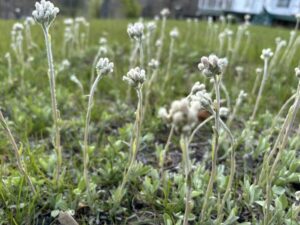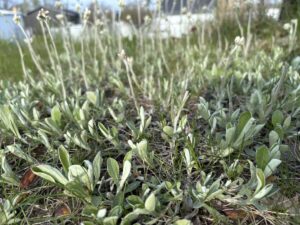Field Pussytoes delight us! (And, we plan to encourage them)
Early this spring a lawn care company dropped by and offered to spray our lawn. “We’ll keep the weeds out,” said the enthusiastic young man.
He knocked at the wrong door. We take joy in our lawn’s diversity, and soon after he visited delightful patches of Field Pussytoes sent up stems with their flowers in our lawn. Serendipity.
Field Pussytoes has the intriguing scientific name of Antennaria neglecta. Ours is one of several species of pussytoes that grace unsprayed yards. The word antennaria comes from the plant’s spikey flowers that look like an insect’s antennae. And neglecta? Well, because we are “neglecting” our lawn by not poisoning it, this humble plant thanks us. It needs little care and grows across much of North America.
This native plant thrives in conditions that describe most lawns. It enjoys full sun to partial shade, spreads by rhizomes, and is one of the earliest lawn “weeds” to flower. Its delicate blooms look like a kitten’s feet and toes. Field Pussytoes is pollinated by insects but bypassed by deer and rabbits.
Many years ago, Marion interviewed Lady Bird Johnson at the Lady Bird Johnson Wildflower Center near Austin, Texas. No doubt the former first lady enjoyed blooming pussytoes. The organization she formed has an outstanding website that helps anyone identify and enjoy plants.
Winding Pathways Lawn Management
We don’t neglect our lawn. We encourage native plants that need little care and which enrich the soil. As needed, we run a mower over it, but we’re always on the lookout for unusual plants that volunteer amid the grass. Some are delightful, and a few could be pests, but all are fascinating.
Our lawnmower helps us select the most interesting plants. Many that we might not want, like invasive sweet clover and garlic mustard, tend to grow tall. Our mower never gives them a chance. Field Pussytoes, like violets, hug the ground and escape the mower’s whirling blade. When done blooming, the plants form loose, sage-green mats that need no mowing at all! Gradually they’ve expanded.
One of the fundamentals of classic ecology is that diversity implies stability. Spraying a lawn destroys diversity, creating an unstable monoculture. We escape cost and possible chemical danger by not spraying our lawn. Pussytoes are just one of many fascinating plants that moved in and have spread on their own.
- Blooms stand up several inches.
- Field Pussytoes hug the ground



